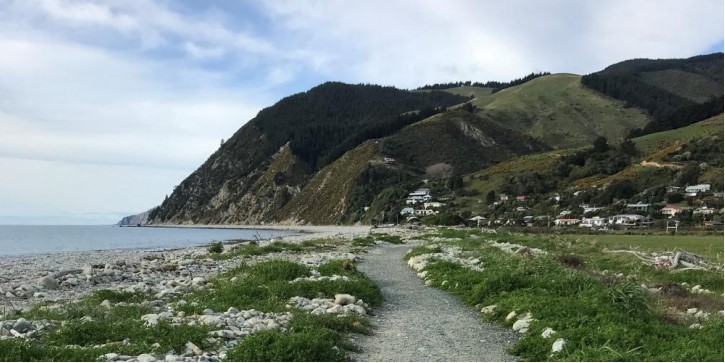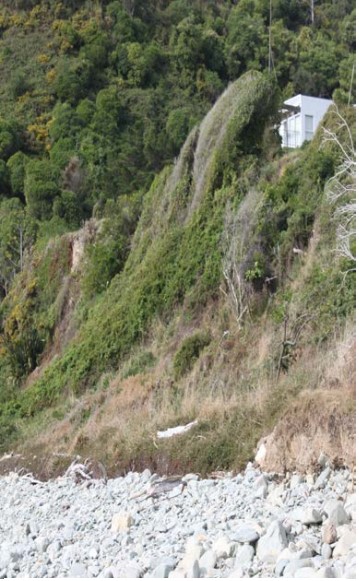Horoirangi and Te Rere a Hihi
Horoirangi (the Sky Washer) is the highest point towering above two boulder banks - the southern end of the boulder bank at Rotokura (Cable Bay), and the northern end of Te Taero o Kereopa, the Boulder Bank enclosing Nelson Haven.
Horoirangi (the Sky Washer) is the highest point towering above two boulder banks - the southern end of the boulder bank at Rotokura (Cable Bay), and the northern end of Te Taero o Kereopa, the Boulder Bank enclosing Nelson Haven. The name also applies to the general locality, Glenduan, more commonly known today as The Glen, which marked the northern coastal boundary of the Nelson Settlement in 1842.
Early Occupation
Jack Walls and others excavated a 1000m2 site “at the northern extremity of the Nelson Boulder Bank”. Unlike excavations at Rotokura (Cable Bay) a short distance north, which revealed layers of successive occupation from Archaic to Classical Māori periods, the site at the Glen shows no stratifications indicating that there was a single-period Archaic or Moa-hunter occupancy, spread over many years. The main activities seem to have been the manufacture of fishing gear, and intensive tool making, with fragments of argillite, sourced from local rivers and D'Urville Island, but not the inland sites such as the Rushpool quarry in the Maitai Valley, scattered throughout the site.
Of the 340 argillite adze fragments found in the area, only one is not of typical Archaic form, although “Virtually no complete adzes were found, most pieces being discards”. All adzes were of argillite, except for one nephrite (pounamu) and one andesite. Other interesting artefacts found include obsidian (volcanic glass) with bright green and grey bands indicating North Island sources, serpentine amulets and pebble adornments, small pieces of nephrite, and approximately 400 argillite drill points, used to make moa-bone fish hooks. As well as the drill points there were other tools, including abraders of varying coarseness and profiles, grindstones, hammerstones and pounders.
The Glen site appears to have been occupied over a period of about 100 years, in the 14th and 15th centuries, but then abandoned. Walls notes:
“When people did return to the Glen they did not reoccupy this old site but established their pa on the spur behind. This pa was in existence at the time of D'Urville’s visit in 1827 and referred to by him as ‘Skoi Tehai’. It was finally deserted after the raid of … about 1830”.
Te Rere a Hihi
J.D. Peart collected a traditional account, from the time of the Tainui-Taranaki conquests of the late 1820s, of a Ngāti Tama chief, Hihi, who almost ran foul of his own exuberance at Horoirangi. As a group of invading waka were coasting south from Wakapuaka towards the start of the Boulder Bank, they encountered a party of Ngāti Apa/Ngāti Kuia at the entrance to the valley. Apa/Kuia fled up the narrow valley and Hihi charged after them as soon as his waka grounded, but in his haste he so far outran his supporting warriors that he no longer had any rearguard protection. Suddenly the tables were turned as Hihi found himself at risk of being surrounded by Apa/Kuia in the confines of the narrowing valley. Hihi was forced to retreat at speed back down the valley with Apa/Kuia in hot pursuit.
The bottom of the gulley ends in a steep bluff approximately 30 metres above the rocky beach. To save himself Hihi leapt at full tilt over the edge, and were it not for the dense cover of flax and bushes on the steep slope, he could have been killed or injured. The vegetation broke his fall, and he tumbled and slid to a safe landing at the foot of the bluff, thwarting his pursuers. Since that time Te Rere a Hihi (leap or flight) has been the Māori name of this locality. Hihi’s daughter, Ngahopi Hihi, was wife of Paremata Te Wahapiro, half-brother of Wi Katene Te Puoho, Ngāti Tama chief at Wakapuaka.
2022
Story by: Mitchell Research
Further Sources
Books
- Te Tau Ihu Statutory Acknowledgements 2014, Nelson City Council, Tasman District Council, Marlborough District Council:
http://nelson.govt.nz/assets/Environment/Downloads/TeTauIhu-StatutoryAcknowledgements.pdf

